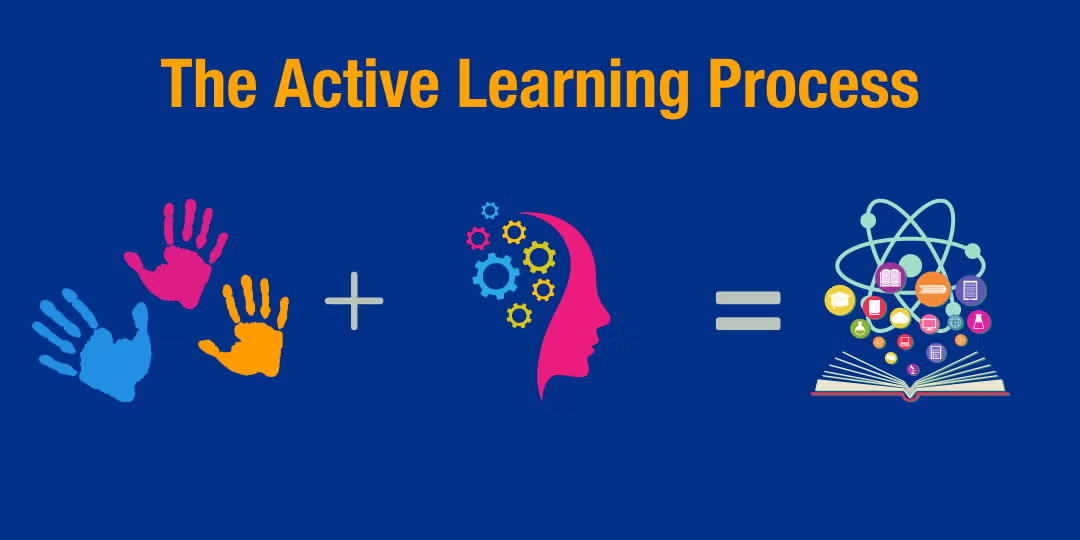Active learning is a teaching and learning strategy that focuses on engaging students in the process of learning by encouraging them to actively participate in their education, rather than passively absorbing information. It shifts the traditional model of learning, where students primarily listen to lectures or read textbooks, to one where they interact with the material, engage in problem-solving, and collaborate with others.
In this article, we’ll explore what active learning is, how it works, its benefits, and examples of active learning strategies.
1. Understanding Active Learning
Active learning is an instructional method that involves students taking an active role in their learning process. It is based on the idea that students learn best when they are actively involved in their own education, as opposed to just receiving information from a teacher or reading it from a book.
In active learning, students might:
- Discuss concepts with peers.
- Apply what they’ve learned to solve real-world problems.
- Create projects or presentations.
- Reflect on what they know and identify gaps in their understanding.
1.1 Theoretical Foundation
Active learning is rooted in constructivist learning theory, which suggests that learners build their own understanding through experiences and interactions with the world around them. According to this theory, knowledge is not something that can be simply “delivered” to students but something they actively construct through engagement and reflection.
2. How Active Learning Works
Active learning involves a variety of techniques designed to promote engagement, critical thinking, and collaboration. Unlike traditional passive learning methods, active learning encourages students to take responsibility for their learning.
Here are a few key principles that define active learning:
2.1 Engagement
Students must engage with the material on a deeper level than simply listening or reading. This could involve asking questions, debating ideas, or making connections between different pieces of information.
2.2 Collaboration
Learning is enhanced through collaboration. Group discussions, peer teaching, and team-based problem-solving activities are all forms of collaborative active learning. These activities allow students to share ideas, test their understanding, and learn from others.
2.3 Reflection
Active learning often involves reflecting on one’s own learning process. Students may be asked to reflect on what they’ve learned, how they’ve learned it, and how they can apply it. This reflection helps to solidify knowledge and improve future learning.
2.4 Application
Active learning emphasizes applying knowledge to real-world scenarios. Instead of merely memorizing facts, students are encouraged to use what they’ve learned to solve problems, think critically, and make decisions.
3. Benefits of Active Learning
There are several reasons why active learning is considered an effective method for promoting deeper understanding and retention of knowledge:
3.1 Improved Retention and Understanding
Active learning encourages students to think critically about the material and apply it in different contexts, which helps to deepen their understanding and improve memory retention. Research suggests that people are more likely to remember information they’ve actively engaged with, rather than information they’ve passively received.
3.2 Enhanced Critical Thinking Skills
Active learning pushes students to analyze, synthesize, and evaluate information, which builds critical thinking skills. By engaging in discussions, problem-solving, and debates, students develop the ability to think critically and make informed decisions.
3.3 Increased Student Motivation
Because active learning encourages student participation and offers opportunities for hands-on experience, it can increase motivation and engagement. When students are involved in their learning process, they are more likely to feel ownership of their education and be invested in the outcome.
3.4 Improved Collaboration and Communication
Collaborative active learning activities, such as group projects or peer discussions, foster teamwork and communication skills. These are essential skills for both academic and professional success.
3.5 Deeper Learning and Long-Term Benefits
Active learning promotes deeper learning by encouraging students to connect new knowledge to existing knowledge, apply concepts to real-life situations, and engage in reflection. This leads to more meaningful learning experiences and a stronger foundation for future learning.
4. Examples of Active Learning Strategies
There are many different active learning strategies that can be used in the classroom or learning environment. Here are some examples:
4.1 Think-Pair-Share
This is a collaborative learning strategy where students first think about a question or topic on their own, then discuss their thoughts with a partner, and finally share their ideas with the entire class. This strategy helps students process their ideas individually before engaging in group discussions.
4.2 Problem-Based Learning (PBL)
In problem-based learning, students work together to solve a complex, real-world problem. PBL encourages critical thinking, collaboration, and the application of knowledge. It also promotes the development of research and problem-solving skills.
4.3 Case-Based Learning
In case-based learning, students examine real-life cases or scenarios that require them to analyze and propose solutions. This method helps students apply theoretical concepts to practical situations, fostering critical thinking and problem-solving skills.
4.4 Role Play and Simulations
Role-playing and simulations allow students to act out different scenarios and explore real-world situations. This type of active learning is especially effective in fields like business, law, medicine, and social sciences, where students can practice decision-making and problem-solving in a safe environment.
4.5 Collaborative Group Work
In group work, students collaborate on a project or task. This can involve researching a topic, solving a problem, creating a presentation, or writing a report together. Group work helps students develop communication and teamwork skills while also encouraging them to learn from their peers.
4.6 Peer Teaching
In peer teaching, students take on the role of the teacher by explaining concepts to their classmates. Teaching others is a powerful way to reinforce one’s own understanding and clarify any misconceptions.
4.7 Flipped Classroom
In a flipped classroom, students first learn the content outside of class (such as through videos or readings) and then use class time for interactive activities like discussions, problem-solving, or applying concepts. This approach shifts the focus of class time from passive listening to active engagement.
4.8 Debates and Discussions
Encouraging students to engage in debates or discussions about a topic fosters critical thinking, argumentation skills, and the ability to consider multiple viewpoints. This strategy can be used to help students analyze complex issues or apply knowledge to real-world situations.
5. Challenges of Active Learning
While active learning has many benefits, there are also some challenges to its implementation:
5.1 Time-Consuming
Active learning activities can take more time to set up and manage compared to traditional lectures. Teachers need to carefully design activities and facilitate discussions, which may require more planning.
5.2 Classroom Management
Active learning often involves collaboration and movement, which can be challenging to manage in larger classrooms. Teachers need to ensure that all students are engaged and stay on task during group activities.
5.3 Student Resistance
Some students may be uncomfortable with the shift from passive learning to active learning, especially if they are used to traditional lectures. Teachers may need to gradually introduce active learning methods and explain their benefits to help students adapt.
6. Conclusion
Active learning is a dynamic and engaging approach to education that encourages students to take an active role in their learning process. By promoting critical thinking, collaboration, and application of knowledge, active learning enhances both understanding and retention. Whether through problem-solving, group work, or interactive discussions, active learning strategies help create a more engaging and effective learning environment.
While implementing active learning may require additional time and effort, its long-term benefits—such as improved learning outcomes, increased motivation, and enhanced skills—make it a valuable strategy for both students and educators.

